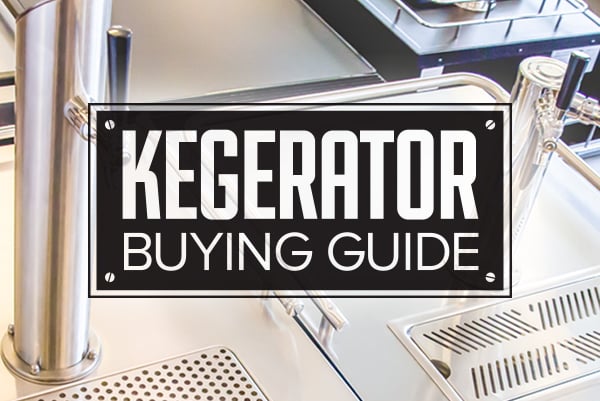
Wondering how many beers are in a keg? Whether you're hosting a party, stocking your kegerator, or running a draft beer setup, knowing how many servings you’ll get from each keg size is key to making sure you’re prepared. In this guide, we’ll break down the most popular keg sizes, their capacities in ounces, and exactly how many 12-ounce or pint-sized servings you can expect from each. Whether you’re a home enthusiast or a bar owner, this information will help you enjoy draft beer at its best.
Download your FREE Keg Size Guide

Enter your email address to get your free keg size guide chart.

Keg Sizes and Types
These different types of kegs each have different characteristics, but if you know what you’re getting into, it will help you make an informed decision about what kind of kegerator you need to maximize your draft beer enjoyment. By familiarizing yourself with the various types of kegs, you can select the one that best
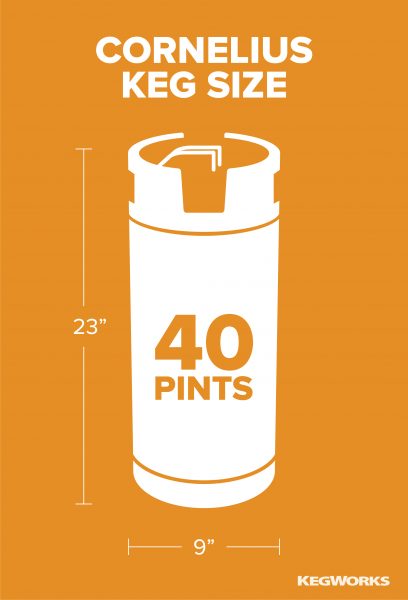
Cornelius Keg
Alternate Names: Corny Keg, Homebrew Keg, Soda Keg
The tall, cylindrical Cornelius Keg (or Corny Keg) was originally developed (and still used) to store, distribute, and dispense soda like Pepsi or Coke.
However, with a five-gallon capacity (the size of a typical homebrew batch) and a design that’s easy to fill, clean, and maintain, Corny Kegs have become very popular with homebrewers who want to skip the process of bottling beer and enjoy their brew on draft.
Most Cornelius Kegs utilize a ball-lock style connection, but some older models still feature a pin-lock style.
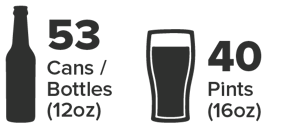
- Pints (16 oz) of beer per keg: Approx. 40
- Cans / Bottles (12oz) per keg: Approx. 53
- Capacity: 5 gallons / 18 liters / 640 ounces
- Dimensions: 23" x 9"

Sixth Barrel Keg
Alternate Names: Sixtel, 1/6 Barrel, 1/6 BBL
A standard Sixth Barrel Keg (⅙ Barrel) is very similar in size, shape, and capacity to a Cornelius Keg but just a little bit bigger (5.16 gallon capacity vs. 5.0 in a Corny Keg). The main difference is that this style doesn’t utilize a ball or pin-lock connection system but a traditional keg valve that requires a keg coupler for dispensing.
⅙ Barrels (or sixtels, as they’re often called) have become increasingly popular because many craft brewers offer their small-batch experiments only in kegs of this size. Furthermore, many beer-minded restaurateurs that want to offer their customers a wide variety will opt for Sixth Barrel Kegs because they take up less space than their bigger brothers.
If you opt for a dual-tap kegerator in your home, you’ll have plenty of options to serve on tap because you can fit two of these in one standard kegerator cabinet.
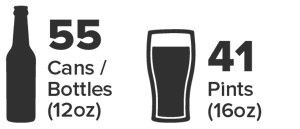
- Pints of beer per keg: Approx. 41
- Cans / Bottles (12oz) per keg: Approx. 55
- Capacity: 5.16 gallons / 20 liters / 661 ounces
- Dimensions: 23⅜" x 9¼"

Quarter Barrel Keg
Alternate Names: Pony Keg, Stubby Quarter, 1/4 BBL
The Quarter Barrel Keg (AKA Pony Keg or Stubby Quarter) looks like the standard beer keg you’re used to from keg parties but much shorter (hence the “stubby” description). It's 7.75 gallons and perfect for small parties.

- Pints of beer per keg: Approx. 62
- Cans / Bottles (12oz) per keg: Approx. 82
- Capacity: 7.75 gallons / 30 liters / 992 ounces
- Dimensions: 13⅞" x 16⅛"
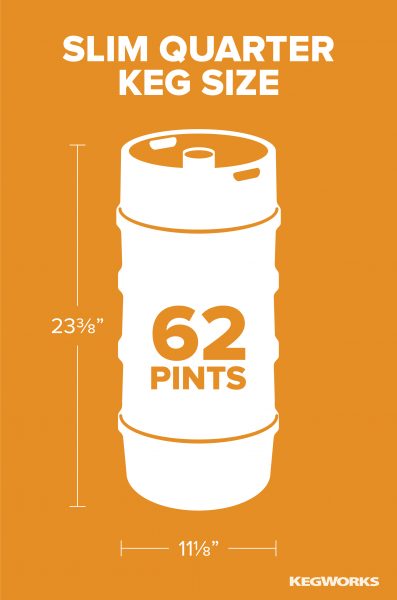
Slim Quarter Keg
Alternate Names: Tall Quarter, Slim 1/4 BBL
This tall, slender keg holds the exact same amount as its stubbier relative, the Quarter Barrel Keg. Much like a ⅙ Barrel, the dimensions of this keg make it a popular choice for people with dual-tap kegerators, but it holds 7.75 gallons, making it more than two gallons larger than a sixtel.

- Pints of beer per keg: Approx. 62
- Cans / Bottles (12oz) per keg: Approx. 82
- Capacity: 7.75 gallons / 30 liters / 992 ounces
- Dimensions: 23⅜" x 11⅛"
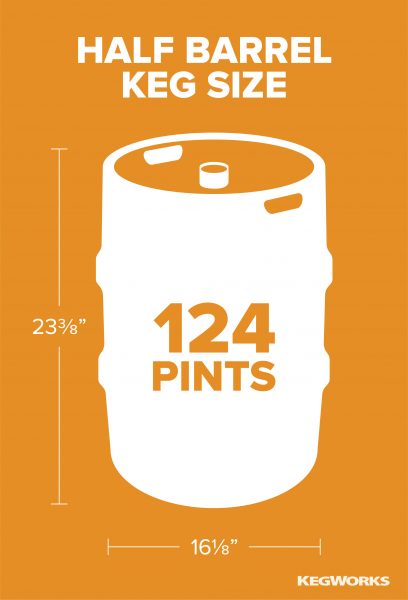
Half Barrel Keg
Alternate Names: Full Size Keg, Full Keg, 1/2 BBL
The granddaddy of them all, the 15.5 gallon Half Barrel Keg is probably what you picture when you think of a beer keg. This vessel has been used to distribute macro brews for generations, and if you’re reading this, you’ve likely served yourself a red Solo cup or two from one of these beauties.
Of course, this is also the keg that most bars and restaurants use, and it will also fit any standard-sized kegerator. If you’re interested in trying new brews, you’ll probably want to stick with the smaller sizes.
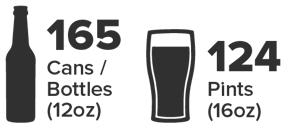
- Pints of beer per keg: Approx. 124
- Cans / Bottles (12oz) per keg: Approx. 165
- Capacity: 15.5 gallons / 58.7 liters / 1,984 ounces
- Dimensions: 23⅜" x 16⅛"
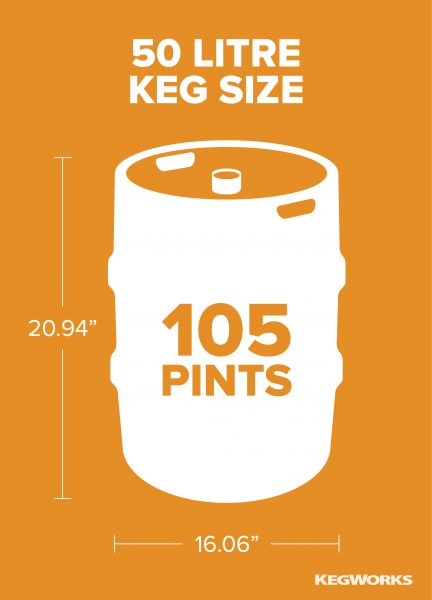
50 Litre Keg
Alternate Names: Import Keg, European Barrel, 50 Liter
A 50 Litre Keg is used by European Breweries and is similar in size to its American cousin, the Half Barrel Keg. This is the most common keg size in European countries, including the UK. Popular import brands in the US include Heineken, Newcastle, Hoegaarden and Stella Artois.
Remember that import kegs do not use a standard US Sankey D coupler. Check our keg coupler guide or ask your supplier to make sure you have the right coupler for your keg.

- Pints (16oz) of beer per keg: Approx. 105
- Cans / Bottles (12oz) per keg: Approx. 140
- Capacity: 13.2 gallons / 50 liters / 1,690 ounces
- Dimensions: 20.94" x 16.06"

Mini Keg
Alternate Names: None
Having a shape similar to a small barrel, a Mini Keg is a perfect option for a small gathering of friends where you might normally bring a 12-pack. The 5-liter mini keg holds about 14 12-ounce pours.
The most popular and easy-to-find version of this keg style is Heineken mini kegs, which contain a CO2 canister to dispense the beer. There isn’t a large selection of mini kegs available, but you can find a few additional imports (ex., Warsteiner, Bitburger) and some craft beers (ex., Bell’s Oberon Ale & Hopslam) depending on where you live. For these mini kegs, you introduce air by opening the bung at the top of the keg and then dispense the beer using the spigot at the bottom.

- Pints (16oz) of beer per keg: Approx. 10
- Cans / Bottles (12oz) per keg: Approx. 14
- Capacity: 1.32 gallons / 5 liters / 1,69 ounces
- Dimensions: 9 ⅞” x 6 ¾”
How Many Beers In A Keg?
| Cornelius Keg | Sixth Barrel Keg | Quarter Barrel Keg | Slim Quarter Keg | Half Barrel Keg | 50 Litre Keg | |
|---|---|---|---|---|---|---|
| Capacity (gal / oz / L) | 5.0 gal 640 oz 18.93L |
5.16 gal 661 oz 19.55L |
7.75 gal 992 oz 29.34L |
7.75 gal 992 oz 29.34L |
15.5 gal 1,984 oz 58.67L |
13.2 gal 1,690 oz 50.0L |
| Pints (16 oz) | 40 | 41 | 62 | 62 | 124 | 105 |
| Bottles / Cans (12oz) | 53 | 55 | 82 | 82 | 165 | 140 |
| Growlers (64 oz) | 10 | 10 | 15.5 | 15.5 | 31 | 26 |
| Corny | Sixtel | ¼ Keg | Slim ¼ | ½ Keg | 50L | |
|---|---|---|---|---|---|---|
| Gal | 5.0 | 5.16 | 7.75 | 7.75 | 15.5 | 13.2 |
| Oz | 640 | 661 | 992 | 992 | 1,984 | 1,690 |
| Liters | 18.93 | 19.55 | 29.34 | 29.34 | 58.67 | 50.0 |
| Pints (16 oz) |
40 | 41 | 62 | 62 | 124 | 105 |
| Cans (12oz) |
53 | 55 | 82 | 82 | 165 | 140 |
| Growler (64 oz) |
10 | 10 | 15.5 | 15.5 | 31 | 26 |
Keg Sizes & Dimensions Quick Reference Chart
| Cornelius Keg | Sixth Barrel Keg | Quarter Barrel Keg | Slim Quarter Keg | Half Barrel Keg | 50 Litre Keg | |
|---|---|---|---|---|---|---|
| Capacity (gal / oz / L) | 5.0 gal 640 oz 18.93L |
5.16 gal 661 oz 19.55L |
7.75 gal 992 oz 29.34L |
7.75 gal 992 oz 29.34L |
15.5 gal 1,984 oz 58.67L |
13.2 gal 1,690 oz 50.0L |
| Height | 23" | 23⅜" | 13⅞" | 23⅜" | 23⅜" | 20.94" |
| Width (Diameter) | 9" | 9¼" | 16⅛" | 11⅛" | 16⅛" | 16.06" |
| Weight (Full) | 55 lbs | 58 lbs | 87 lbs | 87 lbs | 160 lbs | 130 lbs |
| Weight (Empty) | 9 lbs | 16.5 lbs | 22 lbs | 22 lbs | 30 lbs | 28 lbs |
| Alternate Names | Corny Keg | ⅙ Barrel, Sixtels |
Pony Keg, Stubby Quarter |
Tall Quarter | Full Size Keg, Full Keg |
Import Keg, European Barrel, 50 Liter |
Download your FREE Keg Size Guide

Enter your email address to get your free keg size guide chart.
Now that you know your keg sizes, you’ll want to ensure the keg coupler on your kegerator or draft system is compatible with the keg you are buying. Most domestic beers fit the D System Sankey coupler that comes standard on most kegerators. Consult our Keg Coupler List ahead of time to make sure the draft beer you pick will connect to your system.
Tags:
Kegworks
Kegworks has been transforming hospitality spaces since 1998 with expertly crafted architectural metalwork and professional draft beer equipment, helping designers, architects, and bar professionals bring their visions to life.


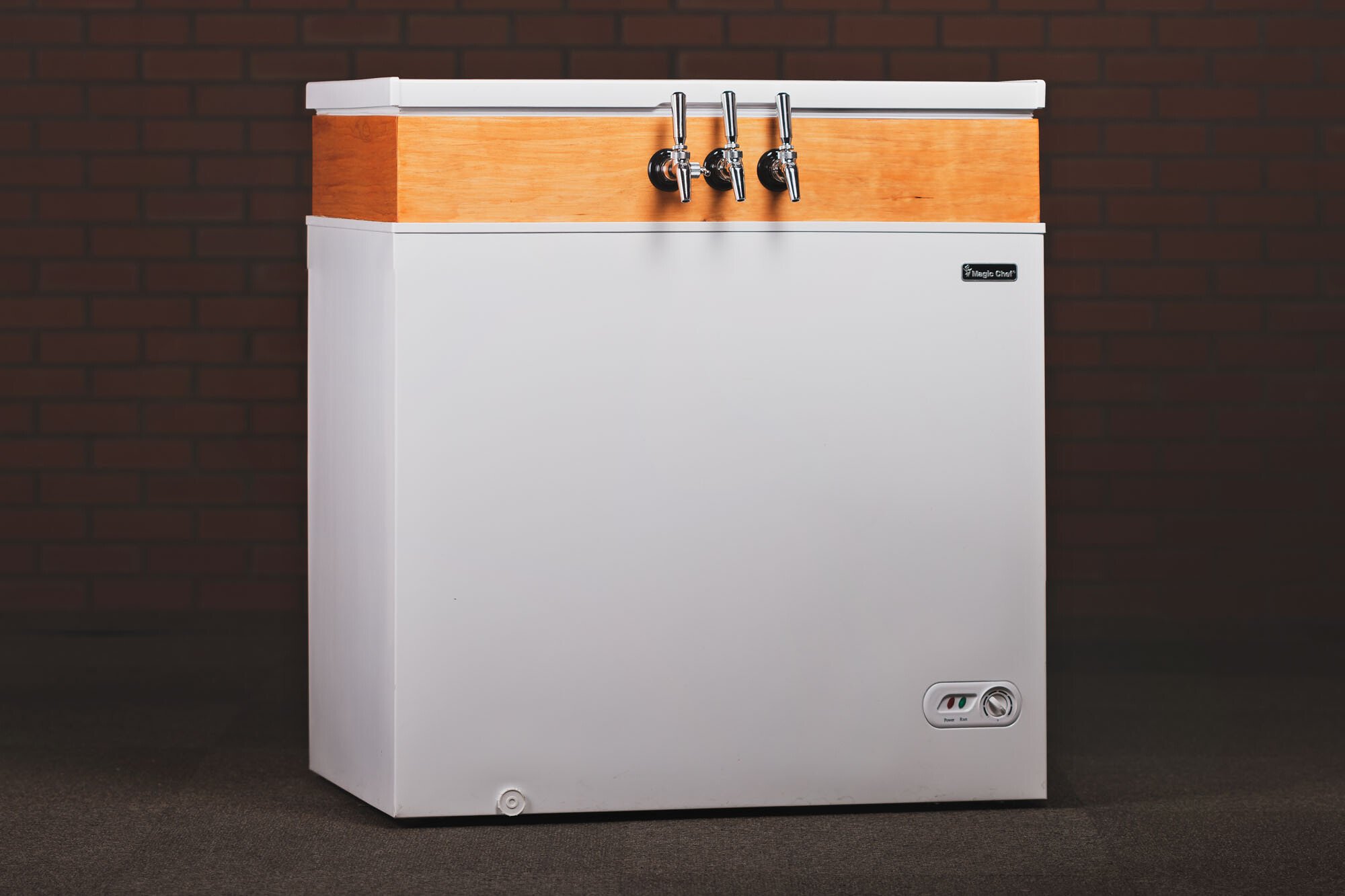
Leave a Comment